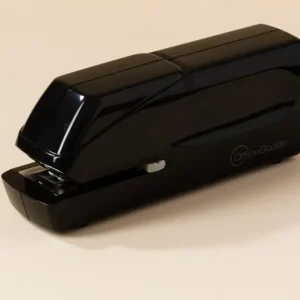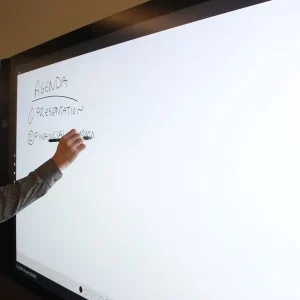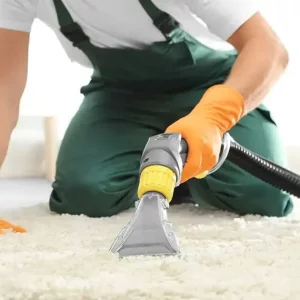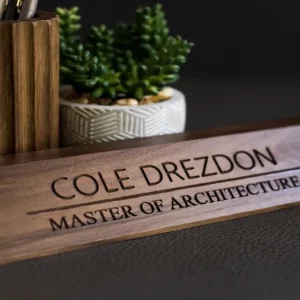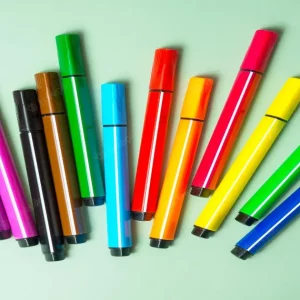Although both devices are used to join woodworking pieces together, Brad Nailer Vs Crown Stapler differ in terms of the size and type of nails or staples they use and the method of operation. A brad nailer uses small, thin nails driven into the wood at an angle, while a crown stapler uses larger, thicker staples driven straight into the wood. Keep reading to know what the difference between them is?
Crown Stapler
As the name suggests, crown staplers use staples to attach things. The staple’s crown is the part that extends from the long legs to the top of the material.

Crown staples are available in a variety of sizes. The gauge (thickness of the staple) and the width of a crown can be different.
The crown widths are commonly referred to as narrow or medium. Holding power is the width of the staple crown, together with the length and width of the legs. The staple’s weight is more significant the more it serves.
There Are Three sizes of Crown Staplers
Narrow Crown: These crown staples are also known as the 90 series. They are incredibly narrow and barely noticeable when they enter the wood.
The holding power of these narrow crown staples is less than other crowns. If you don’t want any staple marks, use a narrow crown stapler.
Medium Crown: Staples with a medium crown are the best of both, offering sturdiness and visibility. For most projects, a medium stapler is the best choice. The staples are usually 16- or 19-gauge.
Broad Crown: These staples have a stronghold power and are incredibly sturdy. They can withstand heavy staple applications.
They are used for roofing, crown molding, house wrap, fencing and other DIY purposes. However, they don’t extend to upholstery. They are usually between 15-16 gauge.
Although they are the most popular, narrow crown staplers don’t hold as well as wide and medium crown staplers.
What Is a Crown Stapler Used for?
Crown staplers can be used for various tasks, from intricate work with narrow crowns to heavy-duty jobs with broad crowns.
Crown staplers are very important in matching the staple and tool to your task. While they are more versatile than brad nailers and can be used for various tasks, it is easier to make mistakes or cause damage by using the wrong staple. A crown stapler is suitable for the following projects:
- Subflooring
- Sheathing made of plywood
- Theatre fabric screens
- Furniture
- Roofing
- Trusses
This is not a complete list. You’ll discover that crown staplers can be used in many other areas of your life, both professionally and like DIY projects. However, you should always ensure that the final product is stable and sturdy.
Different types of Crown Tappers
Crown staplers can attach fabric or other materials onto wooden surfaces. There are many types of them. They are:
Manual Stapler
Manual crown staplers can be operated by hand. You need to insert a stapler in the piston and then push the trigger to attach the stapler to any material. This tool is ideal for minor repairs or construction projects.
Pneumatic Stapler
An air compressor powers the pneumatic stapler. This compressor compresses the stapler and drives it. It is used on large construction sites because of its high-performance design.
Cordless Stapler
The cordless stapler is the third type. It does not require a cord to work, as the name implies. This device uses battery power.
Pros and Cons
- Pros:
- Different sizes available for other applications
- Ideal for heavy-duty stapler work
Cons:
- It is not visually appealing

Brad Nailers
Brads are straight fasteners used by brad nailers. You can choose from a variety of lengths and gauges. The indicator of the brad primarily determines its holding power.
A thinner brad will not hold as well as one wider because it determines what material it will pass through; the length of the brad matters.
Brads and any other fastener should not exceed twice the size of the material they are going through. This will ensure that it holds fast.
What’s a Brad Nailer Used for?
Brad nailers can be used to attach two flat objects and light finishing or decorative work.
Brad nailers use straight nails and a small nail head at their top. This makes them almost invisible on finished projects, but it also means they don’t have much fastening power.
Brad nailers should not be trusted to do heavy-duty stapler work, even if you have placed the nail correctly or used a longer pin.
If the surface you are fastening must be heavy or has a lot of stressors, you will need a giant nail and a larger nail gun.
Brad nailers instead focus on lighter and more delicate materials, which don’t necessarily require a lot in fastening strength. Here are some uses for brad nails:
- Veneer
- Molding
- Thin baseboards
- Interior trims
- Birdhouses/dollhouses
- Picture frames
This is not an exhaustive list.
Brad nailers can be used in almost all situations where a small, relatively innocuous nail may be necessary.
These can be used to hold two boards together during construction and shaping.

Different Types of Brad Nailers
Before comparing crown staplers with brad nailers, it is essential to understand the differences between them. These differences are necessary to understand before reaching crown staplers with brad nailers. There are two types of brad nailers. These are the two types of Brad nailers:
Pneumatic Brad Nailgun
To operate, the pneumatic brad nailer requires compressed air or gas. It requires a compressor to work. The pneumatic nail gun has an air compressor, which supplies compressed air through the hose to the tool.
The brad nails are driven by compressed air when the tool is used. Pneumatic brad nailers can also be called air-powered brad nailers. When plugged into an electric outlet, the pneumatic brad nailer will continue to work.
Electric Brad Nailgun
An electric brad nailer can also be used. An electric motor powers the device. There are two types of electrical brad nailers: cordless and corded.
Cordless Electric Brad Nailgun
An electric brad nailer that is cordless does not require an electrical outlet. They run on battery power.
The cordless electric brad nailer is lightweight and portable. Because there is no cord, you can easily direct the shooting direction.
Corded Electric Brad Nailgun
A corded electric brad nailer, as the name implies, has a long cord. For power, you plug it into an electric outlet. The corded electric brad nailer may not be as portable as the cordless.
Pros and Cons
Pros:
- Clean up after yourself
- Ideal for light-duty tasks
Cons:
- They are not as strong as crown staples

Crown Stapler Vs Brad Nailer – What are the Differences?
Okay, now that you know what brad staplers and crown nailers are, let us find out what makes them different and which one is best for you.
Crown Stapler and Brad Nailer: Contact Points
It is essential to understand the differences between staples and nails.
Staples have two prongs or points of contact/entry. Nails only have one. This makes a big difference in holding power and application.

Brad Nailer Versus Crown Stapler: Penetration Depth
A further difference between these tools and the items they dispense is the depth they can penetrate.
Brad nailers can have nails as long as 2 1/2 or 3 inches. However, crown staplers don’t usually penetrate more deeply than 1/8 inch. This is important for the application because thicker materials, such as wood require staples but not nails.
Brad Nailer or Crown Stapler: Holding power
The holding power of these tools is also different. This can be due to the penetration depth and the shape of staples or nails.
Brad nailers penetrate pretty deep and have good holding power for joining two thin pieces of wood together, such as to attach trim or molding.
However, thin nails with a small head or no head are not recommended for attaching upholstery to wood. Two points of contact are better for holding thin materials like fabrics.
Brad Nailer Vs. Crown Stapler: A variety of Nails/Staples
Brad nailers are limited to 15- or 16 gauge nails. Crown staplers can use staples from 15- to 22 gauge. This difference will not affect your overall selection, but it is something to consider.
Narrow Crown Stapler Vs Brad Nailer: Applications
Brad’s nails are more suitable for applications that require strong holding power for thicker materials. They are also better for applications that don’t require visible nailing, such as attaching wood to wooden (although they are not recommended for heavy-duty tasks).
Brad nailers are not used to attaching 2x4s. Brad nailers can be used to attach lightweight trims and moldings and cabinetry and shelving.
Crown staplers can be used for roofing, insulation trimming, molding, sheathing and carpet laying. Crown staplers are best if you need to attach two thin materials like fabric to wood.
However, attaching two pieces of wood is not something you would use the crown stapler for. It won’t look good, won’t hold well and may cause damage to the wood.
Brad Nailer and Crown Stapler: Material Damage
Brad nailer nails are fragile and don’t have heads so that they won’t cause any damage to the material.
On the other hand, Crown stapler staples can be very heavy and enter the material at two points. This creates twice the damage.
Brad Nailer v Crown Stapler Power Source
Brad nailers can run on electricity, battery or fuel. Staple guns can also be powered with all those things. They can also use manual power.
Brad Nailer and Narrow Crown Stapler: Cost
While you can find low-end models for both tools starting around $80 or $100 each, brad nailers with higher-end capabilities can be twice or three times the price.
What Can a Brad Nailer Use for Staples?
A brad nailer can’t use staples. However, this does not mean that they cannot use pins. There are tools known as brad nailers, combination crown nailers/staple guns and brad nailers. It is almost like a gun with two magazines: one that holds staples and one with nails.
A brad nailer, for example, cannot use staples. However, a combination nailer and stapler can. It’s not difficult to find the right product.
Similarities
Two materials can be bonded together using brad nailers or crown staplers.
Brad nailers, as well as crown staplers, can be operated using compressed air. This allows you to drive the fastener into any wood surface.
Brad nailers and crown staplers have robust designs and can drive a staple or nail into wood with an extraordinary force depending on the fastening tool.
Both crown staplers and brad nailers are made for furniture use. The nailer offers more versatility in other applications.
Both are intended to be permanent solutions.
Which One of the Two Should You Use?
It doesn’t matter which tool you use because they are used in different ways. A crown stapler is not used to build cabinets. A brad nailer is not used to attach carpeting.
Crown staplers can be used for roofing, insulation trimming, molding, sheathing and carpet laying. Brad nailers are for shelving and cabinetry and attaching lightweight fringes and other light tasks.
Brad Nailer Vs Crown Stapler: FAQs

Can Crown Staples Be Used With a Brad Nailer?
There is no way to use a Brad nailgun with crown stapler guns. Brad nailers use T-shaped brad nails of 18 gauge. Crown staplers, on the other hand, use U-shaped wire staplers.
Is It Possible to Use a Brad Nailer on Carpet?
A brad nailgun is not recommended for carpeting. The brad nailgun delivers fragile brad nails that will not penetrate the carpet’s padding or backing. You will need a crown stapler to drive long staples through thick materials.
Does Brad Have Strong Nails?
Brad’s nails are generally weaker than other staples, such as the finish nailer. They are fragile and skinny. Brad nailguns were designed to attach lightweight materials.
What Does a Staple Number Mean?
Two numbers are used to indicate the size of crown staples. For example, 26/6 and 10/5. The first number is the gauge of wire used in mm. The second number is the depth of the leg measured in mm.
Conclusion
There are a few key factors to consider when choosing between a brad nailer and a crown stapler. The first is the size of the project. A brad nailer is better suited for smaller projects, while a crown stapler can handle larger projects.
The second factor is the type of material you’ll be working with. A brad nailer can work with various materials, but a crown stapler is best suited for thicker materials. We hope that our comparison was helpful for you.
